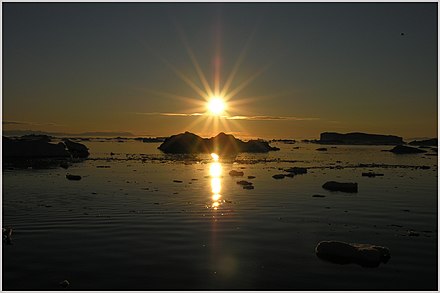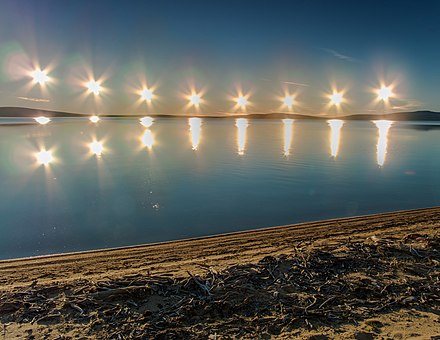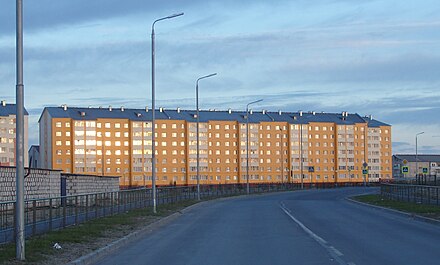Midnight sun
Midnight sun
Midnight sun is the sun being above horizon throughout the night, while polar night is when the sun stays below it even in the day. They can be experienced in the Arctic and Antarctica.
Understand
See also: Astronomy
 The Earth's axis is tilted by 23 degrees in relation to the ecliptic (the plane of its orbit around the Sun) and this causes the seasons. When your part of Earth is tilted toward the Sun, you get summer; when it is tilted away, winter. For any latitude, the angle between vertical and the noon sun ranges from latitude minus tilt at the summer solstice to latitude plus tilt at the winter solstice, and is exactly the latitude on the equinoxes. In the tropics — within 23 degrees of the equator — that range includes 0° so at times the Sun is directly overhead. In Arctic or Antarctic regions — within 23 degrees of the poles — it includes 90° so at times the Sun is on or below the horizon even at noon or is above the horizon even at midnight (the tilt varies somewhat with time, so the figures given here are not exact; also topography matters when the sun is low).
The Earth's axis is tilted by 23 degrees in relation to the ecliptic (the plane of its orbit around the Sun) and this causes the seasons. When your part of Earth is tilted toward the Sun, you get summer; when it is tilted away, winter. For any latitude, the angle between vertical and the noon sun ranges from latitude minus tilt at the summer solstice to latitude plus tilt at the winter solstice, and is exactly the latitude on the equinoxes. In the tropics — within 23 degrees of the equator — that range includes 0° so at times the Sun is directly overhead. In Arctic or Antarctic regions — within 23 degrees of the poles — it includes 90° so at times the Sun is on or below the horizon even at noon or is above the horizon even at midnight (the tilt varies somewhat with time, so the figures given here are not exact; also topography matters when the sun is low).
If you visit the Arctic or Antarctic areas in the winter you will experience the polar night, which means that the sun doesn't rise above the horizon. This offers a good opportunity to see the Aurora borealis, as the sky will be dark more or less around the clock. As the areas are sparsely populated, and light pollution therefore often not a problem, you will also be able to enjoy the stars. There will probably be snow, which will magnify the light from stars, moon and auroras. In addition to the wintry lights, you will also have dawn and dusk, just no sunrise between them. Near the poles, there is twilight only in autumn and spring, and right at the poles there is in a way just one day and one night every year. The sun only rises and sets once a year — the sun emerges around the spring equinox, takes until the summer solstice to reach its highest point and then slowly descends to disappear entirely around the autumn equinox.
A white night is a related phenomenon. When the sun is barely below the horizon at midnight, the sky never turns dark. White nights can be experienced around the summer solstice down to 60 degrees of latitude, in cities such as Oslo, Stockholm, Helsinki and Saint Petersburg. Places closer to the poles have a longer white night season.
Planning
.jpg/440px-Sommernatt_i_Troms%C3%B8_(7466198800).jpg)
Time of the year
To see the midnight sun, you need to be north of the Arctic Circle or south of the Antarctic circle (above 90-23=67° latitude) at a time close to the summer solstice, June 21 in the northern hemisphere or December 21 in the southern. To experience the polar night, you should travel there close to the winter solstice, with the dates the other way around. Going far enough to the north or south the exact date is less important; at the poles midnight sun and polar night will last about half a year each. The website SunCalc can be very useful for figuring out at what time of the year to go.
Time of the day
If you want to see the sun at midnight, you clearly have to be out at midnight. Notice that your watch shows the time of your time zone, which usually is not the same as local sun time. If you want to see the sun at its lowest, it is the latter you have to observe. In Qaanaaq, Greenland, that means 02:37 wall clock time (accounting for daylight saving time). North-western Alaska and some parts of Russia have a similar offset.
For polar night, you can enjoy the darkness most of the time. If you want to take advantage of the dawn and dusk in the middle of the day, be outdoors before first sign of dawn. For auroras, check the separate article.
Weather
Obviously you won't see the sun on a cloudy night, so it is a good idea to check the weather forecast before leaving. Also, some regions have cloud cover more often than others.
Even in midsummer, it can be cold at high latitudes. Near-freezing temperatures are possible at nearly any of the destinations. In most regions you would travel to, temperatures are more likely to be chilly to warm, though.
For polar night, advice for cold weather applies to the extreme: you will be at high latitudes nearly at their coldest time. Tourist businesses may be well equipped to deal with this, but check – and you will need proper clothes also when not being taken care of.
Prepare
Photography
 Some of the most interesting photos of the midnight sun use time lapse techniques to get multiple images of the sun as it drops toward the horizon then reverses direction and begins climbing back into the sky. These require a tripod and a moderately wide-angle lens. The timing can be done manually, but it is much easier if the camera can be set to do it for you.
Some of the most interesting photos of the midnight sun use time lapse techniques to get multiple images of the sun as it drops toward the horizon then reverses direction and begins climbing back into the sky. These require a tripod and a moderately wide-angle lens. The timing can be done manually, but it is much easier if the camera can be set to do it for you.
See travel photography for more general advice.
Ramadan
Muslim may have a problem if they are at high latitudes during the fasting month of Ramadan; the basic rule is that Muslims do not eat or drink while the sun is in the sky during that month; that would be fatal if followed rigorously in summer at high latitude.
Various groups of Muslim clerics allow various modified rules: use Mecca time, the time of the nearest Muslim country or the solar time of your original home country, fast for a fixed number of hours each day, or fast in a different month since in spring or autumn the days are around 12 hours even at extreme latitude. However, some clerics insist that there can be no exceptions.
Muslim travellers should plan ahead for this issue and consult their religious leaders if it is likely to be a problem.
Destinations
By definition, the midnight sun and the polar night can be seen in two areas:
- Arctic regions, including parts of the following (from west to east):
- Arctic Alaska 📍
- Northern Canada 📍 (the northern parts of it)
- Greenland 📍 (most of it)
- Iceland 📍 (some locations)
- Northern Norway 📍 and Svalbard 📍
- Norrbotten 📍 (Sweden)
- Finnish Lapland 📍 (Finland)
- Murmansk Oblast 📍 (Russia)
- north of Urals, Siberia and Russian Far East 📍 (other northern parts of Russia)
- Antarctica (except the northern tip of the Peninsula)
 The Gulf Stream warms northern Europe; the regions with white nights or midnight sun there are much more accessible than elsewhere. Inuvik, one of the biggest settlement where midnight sun can be seen in Canada, has 3,000-some inhabitants, and is at the end of a 737-km mostly unpaved road. In Alaska, the main Arctic settlements Utqiaġvik and Kotzebue have the same magnitude of population (counting seasonal workers in the former). On the other hand, Finnish Rovaniemi at the polar circle has more than 50,000 inhabitants and is served by daily sleeper trains. There are several cities along the Norwegian Arctic coastline, with Tromsø (80,000) having midnight sun for about 10 weeks. Murmansk (280,000), on the Kola Peninsula of Russia, is the world's largest city north of the Arctic Circle, with 2 months of midnight sun, and is served by daily trains. Naryan-Mar (21,000), the capital of Nenetsia, is also in European Russia and due to relatively high standard of living among Russian cities, also suitable for viewing. Farther east, including all of Asian Russia, the Arctic is far off the beaten path, although there are some quite big cities (mostly living from mining, oil, shipping or military), with frequent flights. For example, Norilsk, the greatest Asian city north of the Arctic Circle (175,000), can only be visited by citizens of Russia.
The Gulf Stream warms northern Europe; the regions with white nights or midnight sun there are much more accessible than elsewhere. Inuvik, one of the biggest settlement where midnight sun can be seen in Canada, has 3,000-some inhabitants, and is at the end of a 737-km mostly unpaved road. In Alaska, the main Arctic settlements Utqiaġvik and Kotzebue have the same magnitude of population (counting seasonal workers in the former). On the other hand, Finnish Rovaniemi at the polar circle has more than 50,000 inhabitants and is served by daily sleeper trains. There are several cities along the Norwegian Arctic coastline, with Tromsø (80,000) having midnight sun for about 10 weeks. Murmansk (280,000), on the Kola Peninsula of Russia, is the world's largest city north of the Arctic Circle, with 2 months of midnight sun, and is served by daily trains. Naryan-Mar (21,000), the capital of Nenetsia, is also in European Russia and due to relatively high standard of living among Russian cities, also suitable for viewing. Farther east, including all of Asian Russia, the Arctic is far off the beaten path, although there are some quite big cities (mostly living from mining, oil, shipping or military), with frequent flights. For example, Norilsk, the greatest Asian city north of the Arctic Circle (175,000), can only be visited by citizens of Russia.
The Antarctic region is in the Screaming Sixties – mostly open ocean with strong winds – and southward. The Antarctic Peninsula is the most accessible destination at high latitude on the southern hemisphere, and the Esperanza Base just has white nights; you need to go a few hundred kilometres farther to see the midnight sun.
Cope
With the sun shining all night long, it is often difficult to sleep properly. It might be a good idea to check with your hotel if there are proper thick curtains in the rooms. Be sure to bring a sleep mask.
In a pinch, you might be able to put together makeshift curtains by attaching aluminium foil to the inside of the window to block out the light (complicated if the windows are large).
Stay safe
As always, looking at the sun is dangerous for your eyes. The sun may not look bright when near the horizon, but it is still capable of giving you blind spots.